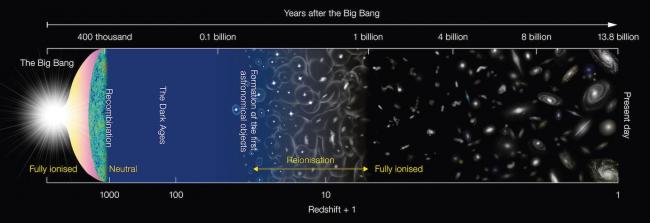- What happened in the early universe?
- Why do galaxies differ so much in size, shape, composition and activity?

A schematic of the evolution of the universe. Astronomers have measured the elemental abundances of galaxies that date from about 1.7 to 4.5 billion years after the big bang, and found that overall the processes producing the elements follow about the same scaling relationships as seen in the local universe.
Astronomers refer to all the elements heavier than helium as "metals," even elements that are typically found in gaseous form. In the big bang only hydrogen and helium (and a trace of lithium) were created while the “metals” were all made subsequently in stellar processes. The abundance of metals in the interstellar medium (ISM) of galaxies – the metallicity of the galaxies – thus quantifies the collective stellar processes that govern galactic evolution. The metallicity of the gaseous phase of the ISM (excluding particulates) has been found to be closely related to the history of a galaxy’s star formation and can be determined using optical spectroscopic observations of atomic lines, especially bright ones from ionized oxygen and neon. Another pivotal process in setting the metallicity is gas flow both out of the galaxy, driven by supernovae or other processes, and into the galaxy from the intergalactic medium.
How the metallicity of galaxies has evolved over cosmic time has become one of the most interesting questions in cosmology because it traces how stars have influenced the elemental composition of the universe in the roughly thirteen billion years since they first appeared, roughly a hundred or more million years after the big bang. CfA astronomer Mojegan Azadi is a member of team performing the MOSDEF survey, a four year program using the Multi-Object Spectrometer For Infrared Exploration (MOSFIRE) on the Keck I telescope to obtain optical spectra of about 450 galaxies in epochs from 1.7 to 4.5 billion years after the big bang. The astronomers measured the metallicity of each galaxy in the sample and concluded that many of the relations involving metallicity in the local universe also apply at these earlier times. For example, the relationship between a galaxy’s metallicity and stellar mass is about the same, as is the correlation between metallicity and star formation rate. These important new results signal that the processes that govern the growth of the element abundances in galaxies, whether by gas flows or star formation, have held in about the same form for at least the past twelve billion years.
Reference: "The MOSDEF Survey: The Evolution of the Mass–Metallicity Relation from z=0 to z∼3.3," Ryan L. Sanders, Alice E. Shapley, Tucker Jones, Naveen A. Reddy, Mariska Kriek, Brian Siana, Alison L. Coil, Bahram Mobasher, Irene Shivaei, Romeel Davé, Mojegan Azadi, Sedona H. Price, Gene Leung, William R. Freeman, Tara Fetherolf, Laura de Groot, Tom Zick, and Guillermo Barro, The Astrophysical Journal 914, 19, 2021.
Related News
CfA Celebrates 25 Years with the Chandra X-ray Observatory
CfA Astronomers Help Find Most Distant Galaxy Using James Webb Space Telescope
Unexpectedly Massive Black Holes Dominate Small Galaxies in the Distant Universe
Distant Stars Spotted for the First Time in the Vast Magellanic Stream
CfA Scientists Help Reach New Milestone in Quest for Distant Galaxies
Astrophysicists Hunt for Second-Closest Supermassive Black Hole
The Tilt in our Stars: The Shape of the Milky Way's Halo of Stars is Realized
JWST Draws Back Curtain on Universe's Early Galaxies
Dozens of Newly Discovered Gravitational Lenses Could Reveal Ancient Galaxies and the Nature of Dark Matter
A Massive Galaxy Supercluster in the Early Universe
Projects
2MASS Redshift Survey
AstroAI
Dark Energy Spectroscopic Instrument (DESI)
GMACS
For Scientists